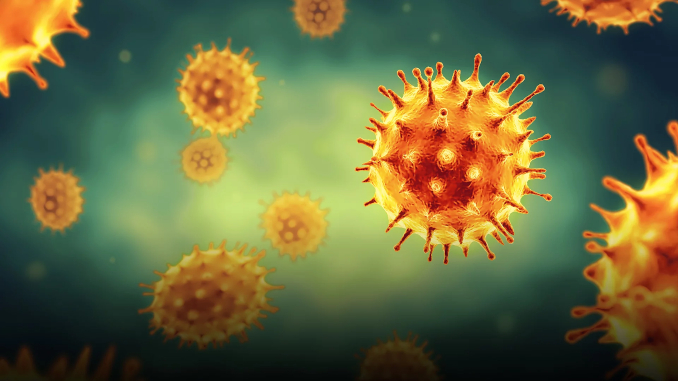
By AFP Staff
In an explosive new report, famed investigative reporter Bill Gertz details how an unsecured, low-level Chinese laboratory near Wuhan, China, had isolated and was studying viruses in bats just before the Covid-19 virus began to spread among residents in the bustling Chinese city. If true, the claim could provide scientists with clues as to how a common respiratory illness in bats jumped from animals to humans before spreading like wildfire across the world.
According to the latest reports, Covid-19, which it is believed originated in or around Wuhan, China, population 11 million, is now present in 151 countries around the world. As testing ramps up in more countries, the United States now leads the world in confirmed cases, with over 164,000 confirmed cases.
Writes Gertz, “Several Chinese state media outlets in recent months touted the virus research and lionized in particular a key researcher in Wuhan, Tian Junhua, as a leader in bat virus work.”
Gertz quoted Rep. Michael T. McCaul, Texas Republican and ranking member of the House Foreign Affairs Committee. McCaul said China should be held accountable for the pandemic.
“This is one of the worst cover-ups in human history, and now the world is facing a global pandemic,” McCaul added.
According to Gertz, a video has been posted online that was funded by the Chinese government. In it, Tian can be seen inside caves in Hubei province near Wuhan taking samples from captured bats and storing them in vials.
“I am not a doctor, but I work to cure and save people,” Tian reportedly says in the video. “I am not a soldier, but I work to safeguard an invisible national defense line.”
An article by “JQKNews.Com” published online in February 2020 discussed a Chinese documentary on Tian’s work collecting specimens from bats in 2019.
Here is an excerpt from that article:
In a documentary released in December last year, Tian Junhua has been out in the daytime and at night in the past decade. He has visited dozens of bat caves in Hubei Province and collected precious bat virus samples.
“In the past ten years, we have visited every corner of Hubei Province, explored dozens of undeveloped caves and studied more than 300 kinds of virus vectors,” Tian said. “If our skin is bare, it’s easy to get in touch with bat feces, pollutants,” he said. The researchers wore protective clothing, goggles, masks, headlights, [and had] flashlights. “We are well prepared for this unknown adventure.”
This is a war without gunpowder. In the film, two researchers armed [sic], climbed the rugged cave wall to remove the captured bats. A staff member wearing gloves grabbed the bat. Tian Junhua put the collected samples of the bat into the specimen box and then put the bat back into the cave.
In May 2017, a report by Xinhua News Agency described Tian’s work: “The environment for collecting bat samples is extremely bad. There is a stench in the bat cave. Bats carry a large number of viruses in their bodies. If they are not careful, they are at risk of infection. But Tian Junhua is not afraid to go to the mountain with his wife to catch Batman.”
Tian Junhua summed up the experience that the most bats can be caught by using the sky cannon and pulling the net. But in the process of operation, Tian Junhua forgot to take protective measures. Bat urine dripped on him like raindrops from the top. If he was infected, he could not find any medicine. It was written in the report.
The wings of bats carry sharp claws. When the big bats are caught by bat tools, they can easily spray blood. Several times bat blood was sprayed directly on Tian’s skin, but he didn’t flinch at all. After returning home, Tian Junhua took the initiative to isolate for half a month. As long as the incubation period of 14 days does not occur, he will be lucky to escape, the report said
We don’t know if Tian Junhua has been so lucky on bat-catching. But scientists have shown that bat viruses can infect people directly, without the need for so-called intermediate hosts.
Most microbiologists dismiss the belief that the virus was manufactured in a lab, arguing that viruses do on occasion jump from animals to humans on their own such as in the case of the Middle East Respiratory Syndrome, which is passed from camels to humans, or the swine and the avian flu—especially when humans and animals live in close proximity to each other, as is the case in Asia.
Gertz’s report, however, could shed light on how this particular virus jumped from bats to humans before morphing into a global pandemic.
At this time, scientists believe they have identified as many as eight different subtypes of Covid-19.
A report in USA Today published March 27 documents these different strains, noting that there is good news to be found in this.
“The SARS-CoV-2 virus first began causing illness in China sometime between mid-November and mid-December,” reported USA Today. “Its genome is made up of about 30,000 base pairs. Humans, by comparison, have more than 3 billion. So far even in the virus’s most divergent strains scientists have found only 11 base pair changes.”
That is good news for scientists and healthcare workers. Finding a cure for one virus is a lot easier than finding cures for eight—or even more—different ones.
According to this report, scientists believe they have located patient X for the United States.
“Most cases on the U.S. West Coast are linked to a strain first identified in Washington state,” reports USA Today. “It may have come from a man who had been in Wuhan, China, the virus’s epicenter, and returned home on Jan. 15. It is only three mutations away from the original Wuhan strain, according to work done early in the outbreak by Trevor Bedford, a computational biologist at Fred Hutch, a medical research center in Seattle.”


